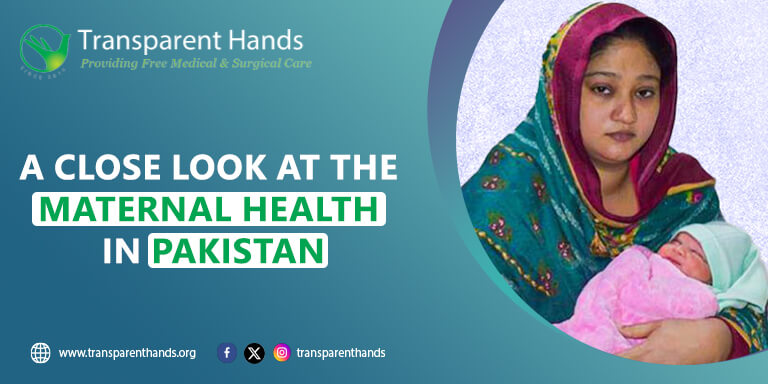A Close Look at the Maternal Health in Pakistan

Maternal health is a state of complete physical, mental, and social well-being of a woman during pregnancy, childbirth, and the postpartum period. It is a critical issue in Pakistan, where maternal mortality rates are among the highest in the world.
Why is the maternal mortality rate so high? What are the causes for it and what is the landscape of maternal health in Pakistan? In this blog, we will explore all of this and more.
Maternal Health in Pakistan: An Overview
Maternal health is a critical issue in Pakistan, where maternal mortality rates are among the highest in the world. In 2020, the MMR in Pakistan was 186 deaths per 100,000 live births. This means that for every 100,000 live births, 186 women die from pregnancy-related complications.
There are several causes of maternal mortality in Pakistan. These include:
Limited access to healthcare: Many women in Pakistan, especially those living in rural areas, do not have access to quality healthcare services. This can make it difficult for them to get the care they need during pregnancy and childbirth.
Poor nutrition: Many women in Pakistan are malnourished, which can increase their risk of developing pregnancy complications.
Early marriage and childbearing: Early marriage and childbearing are common in Pakistan, which can also increase the risk of maternal mortality.
Domestic violence: Domestic violence is also a problem in Pakistan, and it can have a severely negative impact on women’s health, including their maternal health.
8 Ways to Improve Maternal Health
Causes of Maternal Mortality in Pakistan
The most common causes of maternal mortality in Pakistan are:
Hemorrhage: Hemorrhage is the leading cause of maternal death in Pakistan, accounting for over 30% of all maternal deaths.
Sepsis: Sepsis is an infection that spreads throughout the body and can be fatal. It is the second leading cause of maternal death in Pakistan, accounting for over 15% of all maternal deaths.
Eclampsia and pre-eclampsia: Eclampsia and pre-eclampsia are pregnancy complications that can lead to high blood pressure and seizures. They account for over 15-25% of all maternal deaths in Pakistan.
Obstructed labor and abortion: Obstructed labor is a condition in which the baby cannot pass through the birth canal. OL along with abortion account for 5-10%, of all maternal deaths in Pakistan.
How to Improve the Health of Mothers and Children in Pakistan
Infant Mortality Rate in Pakistan
Pakistan’s infant mortality rate in 2023 is 55.777 deaths per 1000 live births, which is a 1.95% decline from 2022. In 2022, it was 56.888 deaths per 1000 live births, a 1.91% decline from 2021.
In simpler terms, this means that the number of babies who die before their first birthday in Pakistan has decreased slightly over the past two years. This is a positive development, but there is still room for improvement, as Pakistan’s infant mortality rate is still higher than the global average.
The high infant mortality rate in Pakistan is due to many factors, including:
Maternal mortality: Maternal mortality is a major factor in infant mortality, as it can lead to the death of the baby before or during childbirth.
Malnutrition: Malnutrition is also a major factor in infant mortality, as it can weaken babies and make them more susceptible to disease.
Infectious diseases: Infectious diseases, such as pneumonia and diarrhea, are also common causes of infant mortality in Pakistan.
Lack of access to healthcare: Many families in Pakistan do not have access to quality healthcare services, which can make it difficult for them to get the care their babies need.
How can maternal and infant health in Pakistan improve?
There are a number of things that can be done to improve maternal and infant health in the country including:
Improving access to healthcare: It is important to improve access to quality healthcare services for all women in Pakistan, regardless of their income or location. This can be done by building more healthcare facilities and training more healthcare workers.
Improving nutrition: It is also important to improve nutrition among women and children in Pakistan. This can be done by providing nutrition education and by providing access to nutritious foods.
Reducing early marriage and childbearing: Early marriage and childbearing are major risk factors for maternal and infant mortality. It is important to reduce early marriage and childbearing by educating girls and their families about the risks and by providing girls with access to education and employment opportunities.
Preventing domestic violence: Domestic violence is another major risk factor for maternal and infant mortality. It is important to prevent domestic violence by educating the public about the issue and by providing support services for victims of domestic violence.
Top 5 Public Health Issues in Pakistan
Conclusion
Infant and maternal health in Pakistan are critical issues. The government and other stakeholders need to work together to improve access to healthcare, nutrition, and education in order to reduce maternal and infant mortality rates.










Leave Your Comments